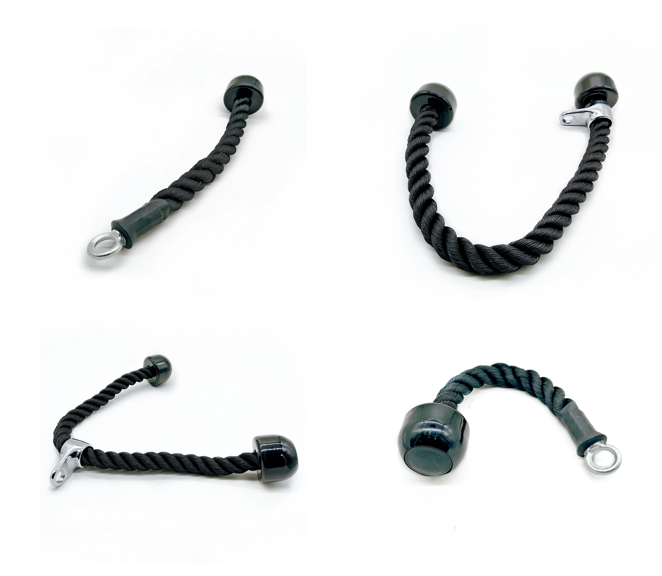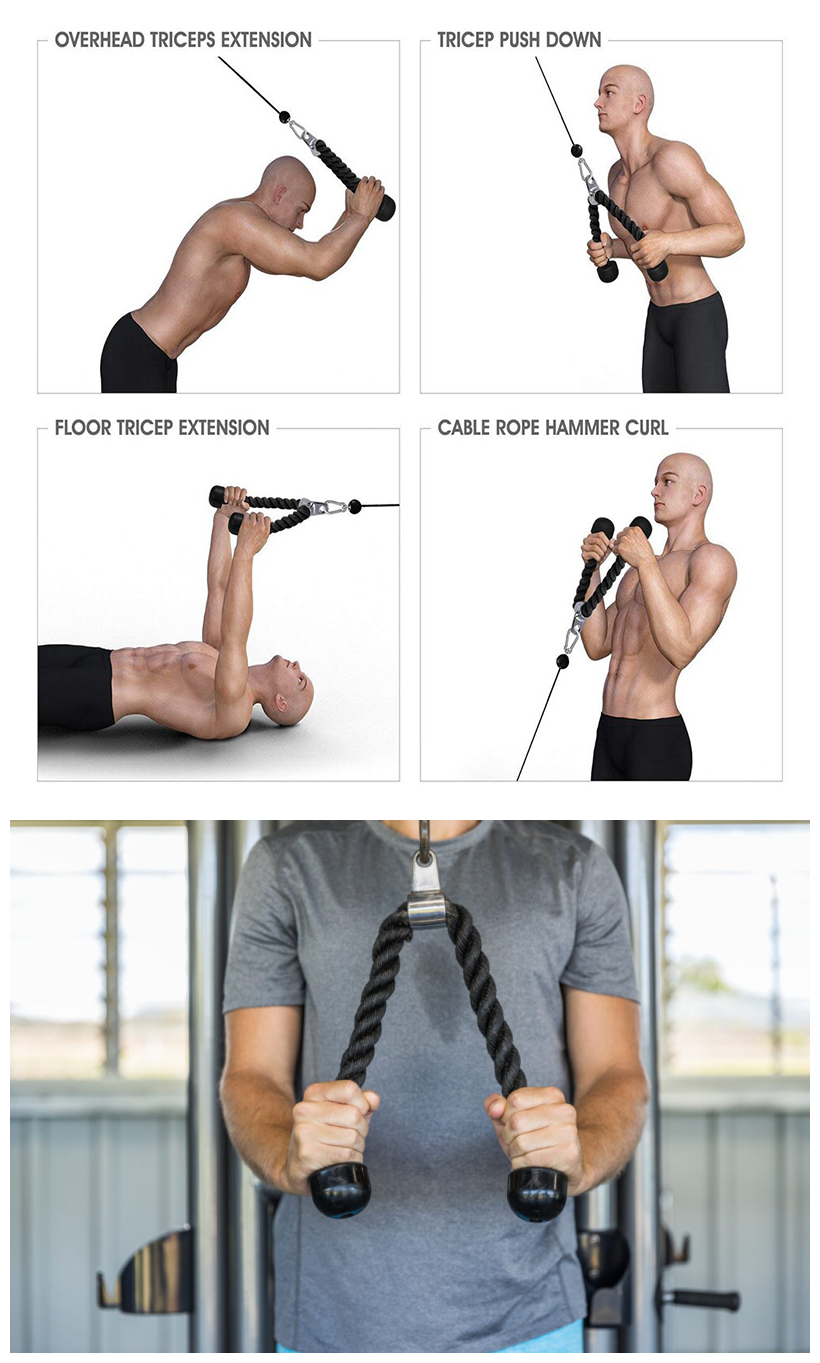Gym Pulley Fitness Cable Attachments Single or Double Bicep Triceps Rope
Tricep Rope and Bicep Rope: Versatile Arm Training Tools
The Tricep Rope and Bicep Rope are essential fitness accessories commonly used in strength training to target the upper body muscles, particularly the triceps and biceps. These ropes are available in both single-head and double-head configurations, providing a range of workout options to suit different training styles. They are typically used with cable machines but can also be adapted for home use with adjustable resistance systems. Below is a detailed look at their features, materials, usage, and benefits.
1. Features and Materials:
Durable Construction:
Both the Tricep Rope and Bicep Rope are made from high-quality nylon or polyester, ensuring long-lasting durability and resistance to wear and tear. These materials are strong enough to withstand heavy resistance and repetitive use.
Grip Design:
Each rope is fitted with foam or rubber-coated handles on both ends to provide a comfortable and secure grip during exercises. These handles are designed to minimize slippage, offering better control and safety, even during high-intensity workouts.
Metal Attachments:
Both ropes feature metal clips or carabiners for easy attachment to cable machines or resistance systems. This allows users to quickly adjust the setup for different exercises.
Single-Head vs. Double-Head:
Single-Head Rope: Typically features one central rope attachment point and is ideal for individual exercises that require a single hand or arm to be used at a time (e.g., single-arm tricep pushdowns).
Double-Head Rope: Features two separate ropes at the end, allowing users to grip both ropes simultaneously with each hand. This is ideal for exercises that engage both arms at once, such as bilateral tricep pushdowns or bicep curls.
2. Usage and Exercises:
Tricep Rope (Targets Triceps):
Primary Use: The Tricep Rope is designed to isolate and engage the triceps (the muscles at the back of the upper arm).
Tricep Pushdown: One of the most common exercises, where the rope is attached to a high pulley. The user pulls the rope downward while keeping elbows close to the torso.
Overhead Tricep Extensions: Engages the long head of the triceps, helping to build arm mass.
Tricep Kickbacks: Focuses on toning the triceps by extending the arm behind the body while keeping the upper arm parallel to the ground.
Bicep Rope (Targets Biceps):
Primary Use: The Bicep Rope targets the biceps (the muscles at the front of the upper arm).
Bicep Curl: Attach the rope to a low pulley, and curl the rope toward your chest to engage the biceps in a more natural motion than traditional barbell curls.
Hammer Curls: This variation helps work both the biceps and forearms, engaging different muscle fibers.
Reverse Curls: Focuses on building the brachioradialis muscle in the forearm.
3. Benefits:
Muscle Isolation and Activation:
Both the Tricep and Bicep Ropes allow for targeted muscle isolation, which helps to specifically engage the triceps or biceps for better muscle development and strength gains.
Versatility:
These ropes offer a wide range of exercises that can work multiple muscle groups. Beyond arms, the ropes also engage the shoulders, forearms, and even the core when used with twisting motions or full-body engagement.
Improved Range of Motion:
The rope design allows for a full range of motion, ensuring that muscles are activated through their complete range, which helps with strength development and injury prevention.
Comfort and Control:
Foam or rubber-coated handles provide a comfortable grip, reducing hand fatigue and offering better control during workouts.
Durability:
Both ropes are made to last, constructed with durable, high-strength materials that ensure they can withstand intense training sessions in commercial gyms or home settings.
-
Cautions:
1. **Proper Warm-Up**: Engage in dynamic stretching or light cardio before starting to prepare muscles and joints for intense movement.
2. **Correct Form**: Maintain a stable stance (e.g., knees slightly bent, core engaged) to avoid strain on the lower back. Grip the ropes firmly but avoid over-tightening, which may lead to wrist fatigue.
3. **Controlled Intensity**: Adjust the length and thickness of the ropes based on your fitness level. Beginners should start with shorter sessions (e.g., 20–30 seconds) and gradually increase duration to prevent overexertion.
4. **Hydration and Recovery**: Avoid excessive water intake immediately before or during workouts, as it may cause discomfort. Replenish fluids moderately after exercise.
5. **Equipment Check**: Inspect the ropes and anchors for wear or damage before use to prevent accidents. Ensure the ropes are securely fastened.
6. **Post-Workout Care**: Allow time for cool-down stretches and avoid sudden stops to regulate heart rate. Refrain from immediate showers after intense sessions to let the body return to a resting state.




















